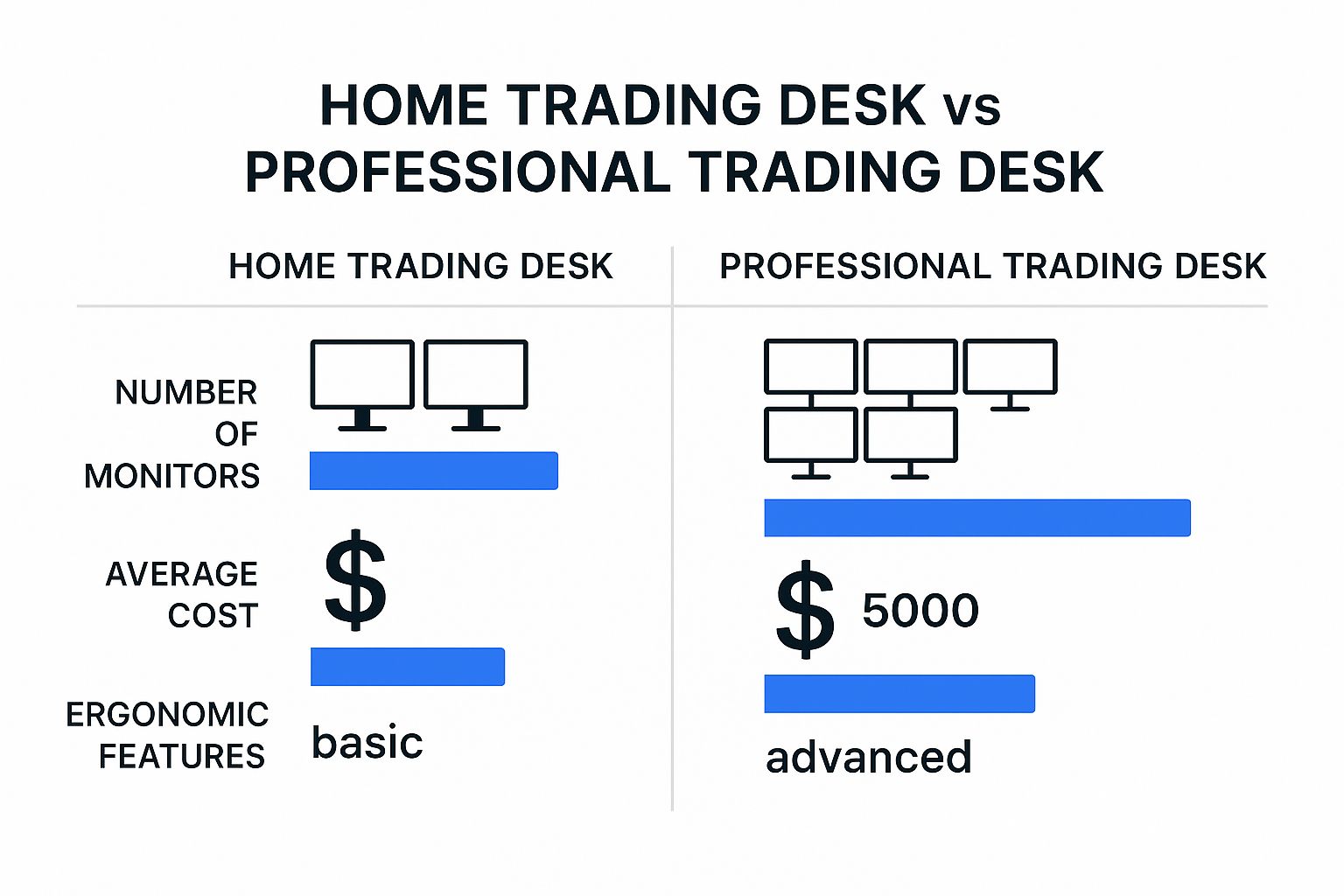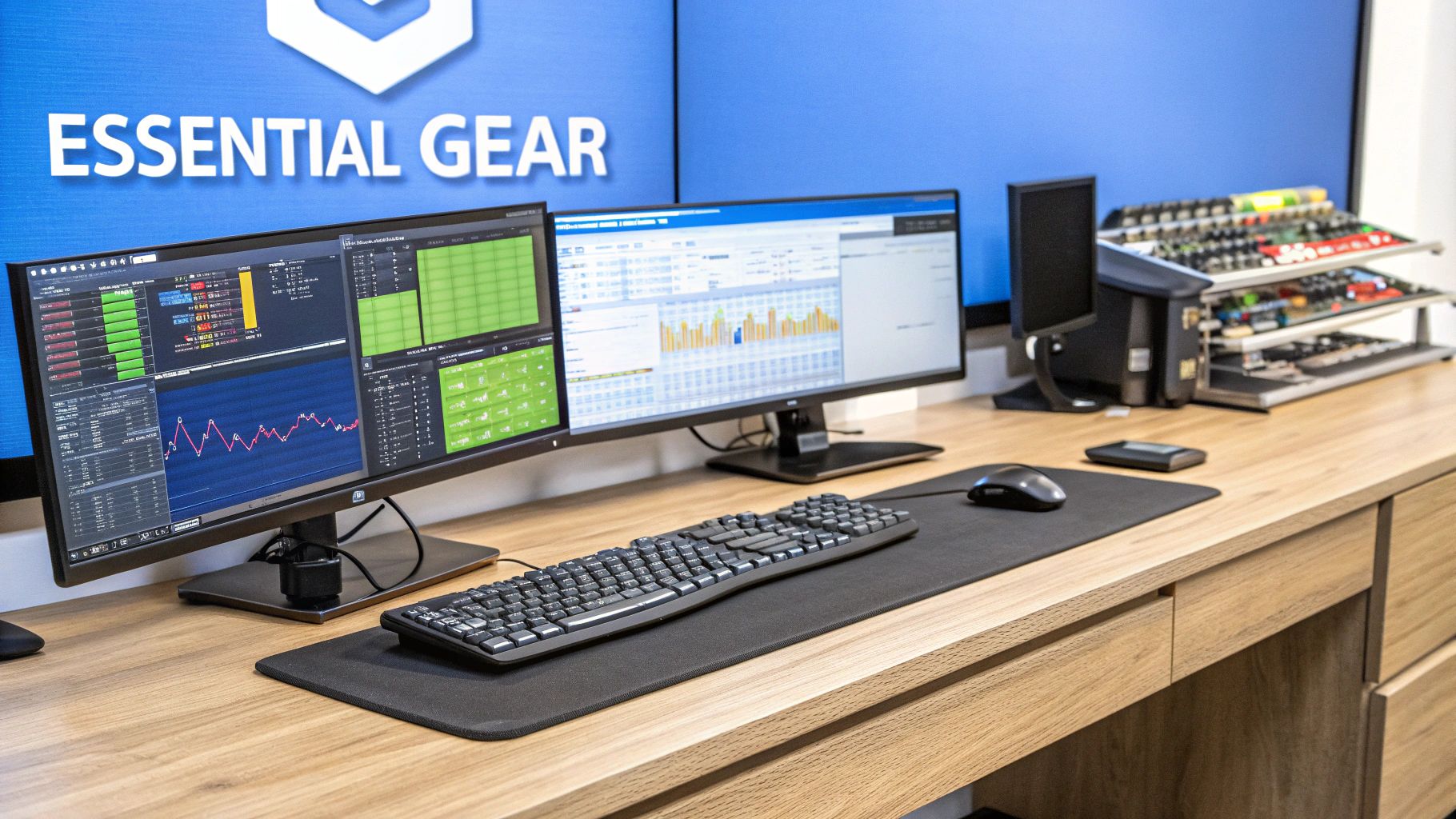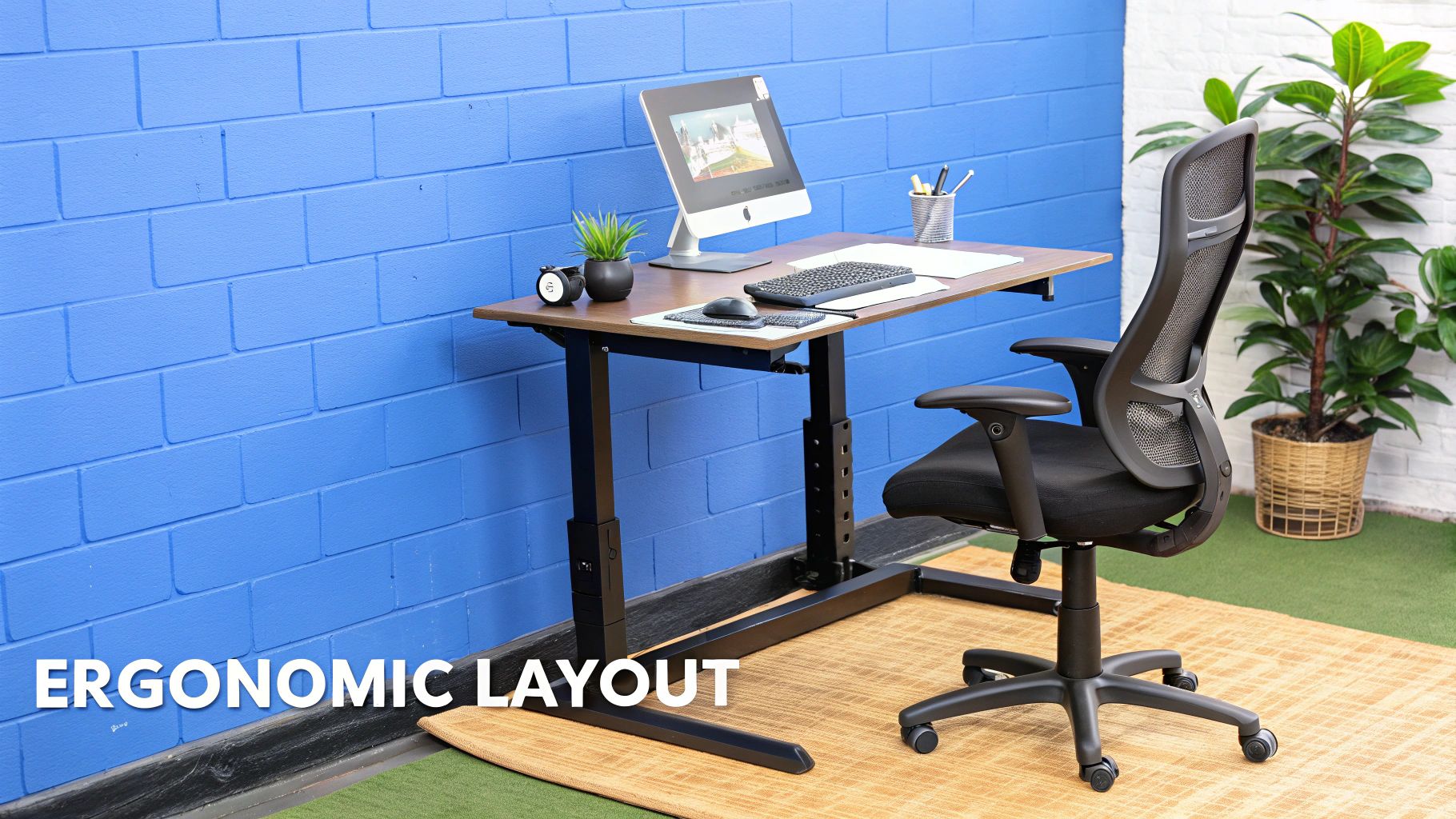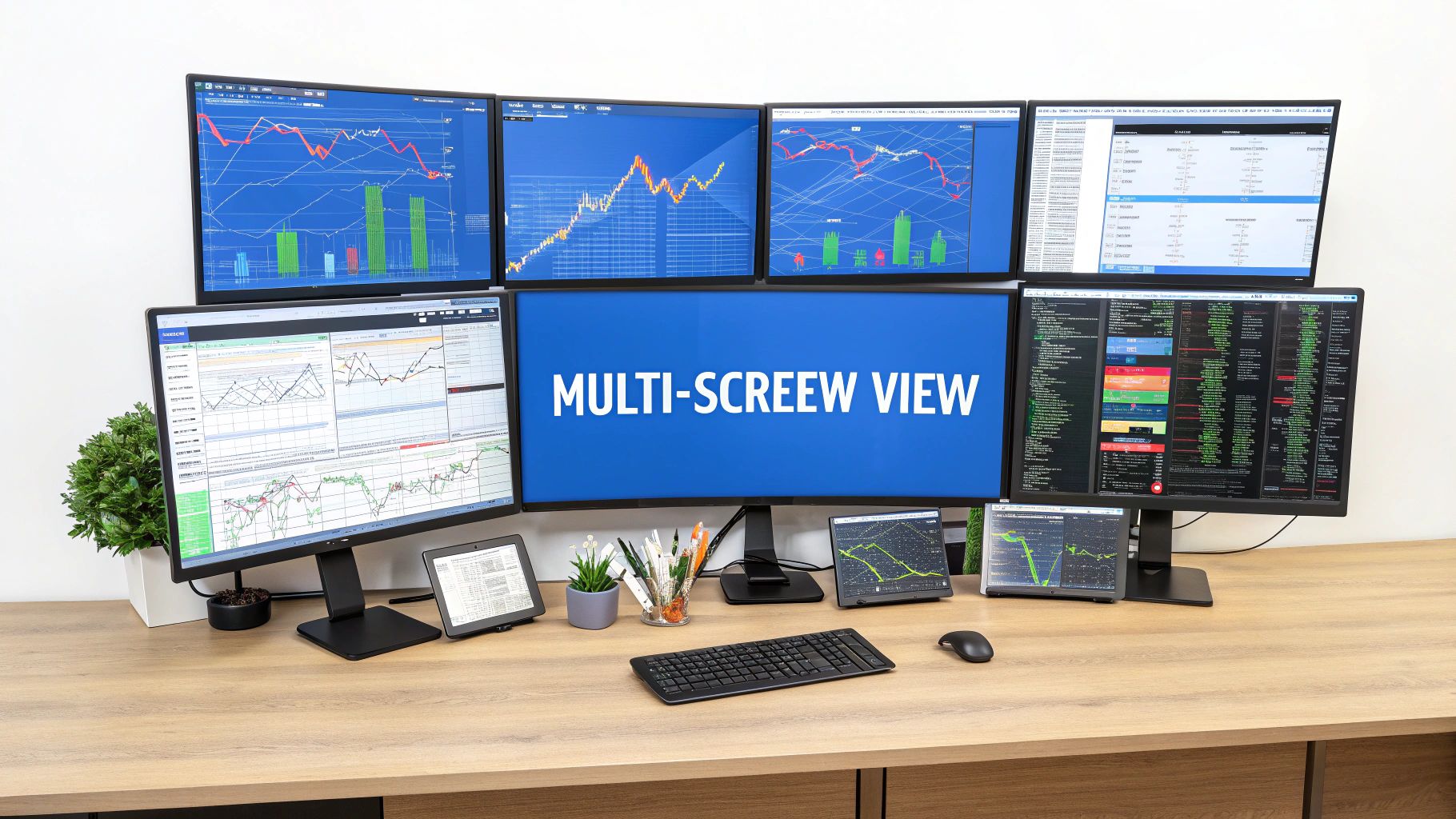Perfect Your Trading Desk Setup | Expert Tips & Strategies
The Foundation of Trading Success: Core Desk Components
Behind every successful trader is a well-equipped trading desk setup. It's not about having the flashiest tech, but about a functional workspace that promotes smart decisions and quick action. This means choosing the right hardware and software, as different trading styles have different needs. A day trader, for example, needs real-time data and fast order execution. A swing trader might prioritize in-depth charting and historical market analysis tools. Knowing your trading style is key before buying any equipment.
Essential Hardware for Your Trading Desk
A solid trading desk starts with reliable hardware. A powerful computer with a multi-core processor is essential. This allows for seamless multitasking and complex calculations. Sufficient RAM is also critical for running multiple applications smoothly. This base allows for using complex mathematical models and real-time data analysis. Professional traders, for instance, prioritize an environment that supports complex calculations and quick decision-making. This includes carefully choosing hardware and software, such as processors for real-time calculations, storage for historical data, and network interfaces for getting market data. Learn more about setting up your desk here: Trading Desk Setups for Success.
-
High-Speed Processor: Crucial for complex trading algorithms and charting software.
-
Ample RAM: Keeps everything running smoothly and prevents slowdowns.
-
Reliable SSD Storage: Allows quick access to your data and programs.
-
Multiple Monitors: Expands your workspace and boosts efficiency.
-
Ergonomic Keyboard and Mouse: Keeps you comfortable during long trading sessions.
Software That Powers Performance
The right software is just as important as the right hardware. Your trading platform should offer real-time data, advanced charting, and custom alerts. Adding news aggregators, market scanners, and risk management software can give you a real advantage. Essential tips for your trading desk setup offers more helpful advice. Integrating these different software components effectively is a key consideration.
Matching Your Setup to Your Trading Style
The table below, "Essential Trading Desk Components", shows the core hardware and software needed by different types of traders, highlighting key differences and similarities. The following data chart visualizes these differences, illustrating the percentage of traders in each category that prioritize each component.
To illustrate this further, the data chart shows that 95% of day traders prioritize high-speed processors, while only 60% of swing traders do. This difference demonstrates the importance of tailoring your setup to your specific trading style.
| Component | Day Trader | Swing Trader | Algorithmic Trader |
|---|---|---|---|
| High-Speed Processor | Essential | Important | Essential |
| Multiple Monitors | Essential | Important | Less Crucial |
| Real-Time Data Feed | Essential | Important | Essential |
| Backtesting Software | Less Crucial | Important | Essential |
| Automated Trading Software | Optional | Less Crucial | Essential |

As the data chart reveals, the hardware and software needs vary considerably between day traders, swing traders, and algorithmic traders. Day traders heavily emphasize speed and real-time data, reflected in the high percentage prioritizing high-speed processors and multiple monitors. Algorithmic traders require powerful processing and backtesting capabilities. Swing traders, while valuing important components like real-time data, place less emphasis on the absolute fastest processing speeds.
By understanding these core components and how they work together, you can create a trading desk that not only meets your current needs but also adapts as your strategy evolves. This foundation will help you navigate the market with confidence and reach your full potential.
Mastering Multi-Monitor Configurations That Drive Results

A well-designed trading desk isn't just about multiple screens; it's about strategically organizing information to improve trading performance. Think of your setup like the cockpit of an airplane. Every display has a purpose, giving the pilot crucial information for decision-making. Your monitors should provide a clear, comprehensive market overview. You might find this helpful: The Ultimate Guide To Multiple Monitor Trading Setup Strategies and Best Practices.
From Three Screens to Six and Beyond: Finding Your Optimal Setup
The three-monitor setup remains a popular choice, offering space for charts, watchlists, and news. However, the ideal number of monitors depends on your trading style and preferences. Day traders might use four or more screens to track numerous stocks and execute trades quickly. Three might be sufficient for swing traders.
This rise in multi-monitor setups reflects increased trading accessibility. The trading community has expanded globally. 95% of traders are outside major financial hubs, with 50% in Asia. This has led to diverse trading desk setups, catering to individual needs. Find more detailed statistics here. Consider a modern Desk Management System to optimize your workflow when setting up your core desk components.
Resolution, Positioning, and the Curve: Maximizing Visual Clarity
High-resolution monitors are crucial for clear chart analysis and spotting subtle price changes. 1920x1080 resolution is a minimum, with higher resolutions gaining popularity for greater detail. Screen placement is also important. Incorrect monitor positioning can cause neck strain, impacting focus and decisions.
Organizing Your Data Streams: A Strategic Approach
The best multi-monitor setup supports your trading strategy. Organize your data streams – charts, news feeds, order books, and other tools – effectively. A day trader might dedicate one monitor to Level 2 data, while another displays charts and technical indicators.
Consider screen size, resolution, and curvature when selecting monitors. Curved monitors can be immersive, but their benefits for trading are debatable. Experiment to find what suits you best. A well-organized, ergonomic multi-monitor setup can significantly boost your trading performance, giving you the informational edge to succeed in today's markets.
Trading Desk Ergonomics: The Hidden Performance Multiplier

A powerful computer and multiple monitors are essential for any serious trading desk setup. However, even the most advanced technology won't maximize your potential if you’re physically uncomfortable. This is where ergonomics, the science of designing a workspace to fit the user, becomes a critical factor. A proper ergonomic setup can significantly impact your trading performance by extending your focus and improving decision-making.
The Impact of Ergonomics on Trading Performance
The importance of ergonomics is often overlooked in trading. Its impact, however, can be substantial. Imagine trying to make rapid, informed decisions during a volatile market session while struggling with a stiff neck or eye strain.
These physical discomforts can significantly affect your ability to concentrate and react effectively. A comfortable and efficient trading desk setup is not just a nice-to-have; it’s a crucial element for success.
Key Ergonomic Considerations for Your Trading Desk
Several key ergonomic factors can dramatically improve your trading experience. Desk height, for instance, is essential. Your desk should be positioned so that you can type with your elbows bent at a 90-degree angle. This will prevent wrist strain and encourage better posture.
Chair selection is equally important. A good ergonomic chair provides proper lumbar support, maintaining correct spinal alignment and minimizing back pain, especially during extended trading sessions.
-
Monitor Placement: To minimize eye strain and neck pain, position your monitors at arm's length and slightly below eye level.
-
Keyboard and Mouse Position: Keep your keyboard and mouse close to your body, preventing unnecessary reaching and shoulder strain.
-
Lighting: Adjustable lighting is important to minimize glare and reduce eye fatigue.
-
Breaks: Regular breaks are vital for both physical and mental well-being. Make it a habit to stand up, stretch, and walk around every 30-60 minutes.
Creating an Environment for Optimal Performance
Beyond the physical setup of your desk and chair, the overall trading environment contributes significantly to your performance. Room temperature, for example, can influence focus and alertness. A slightly cooler temperature is generally considered conducive to concentration.
Managing noise levels is also crucial. Excessive noise can be distracting and increase stress levels. Consider using noise-canceling headphones or exploring ways to soundproof your trading space. When these environmental factors are properly addressed, they create a more conducive atmosphere for focused trading.
Addressing Common Trading Desk Ailments
Many traders experience issues like eye strain, back pain, and mental fatigue, especially during periods of intense market activity. Implementing good ergonomic practices can substantially alleviate these problems. Investing in a high-quality ergonomic chair and correctly positioning your monitors are key steps.
Even seemingly small adjustments, like modifying your lighting and taking regular breaks, can make a world of difference. By addressing these common issues, you create a workspace that not only supports your physical well-being but also enhances your trading performance and promotes long-term success in the market.
Building Bulletproof Digital Infrastructure for Reliable Trading
A truly effective trading desk isn't just about having the latest hardware. It's about building a solid digital infrastructure you can depend on. In the fast-paced world of trading, every millisecond matters. That's why the technical side of things, often overlooked, is absolutely crucial for consistent success. Let's explore how to create a resilient digital foundation for your trading setup.
Connectivity: The Lifeline of Your Trading Desk
Fast, reliable internet is everything in trading. A dropped connection, even for a short time, can mean lost opportunities and big losses. Redundant internet connections are a must-have for any serious trader. A backup connection, either through a different provider or technology (like 4G/5G as a fallback for your wired connection), keeps you trading even if your primary connection goes down. This minimizes downtime and keeps you connected to the market. Trading efficiency also depends on how fast you execute trades, and learning keyboard shortcuts can make a significant difference.
Data Feeds: The Fuel for Informed Decisions
Your trading decisions are only as good as the data they're based on. Delayed or inaccurate data feeds can lead to bad trades and financial setbacks. It's essential to carefully evaluate the reliability and latency of your data provider. Look for providers with a strong history of uptime and minimal delays. Consider using multiple data feeds for crucial information – this provides a way to cross-check data, increasing accuracy and reducing reliance on potentially faulty information.
Power: Ensuring Uninterrupted Operation
Power outages are a trader's nightmare. Lost connections and unsaved data can have severe consequences. A solid power backup system is non-negotiable. A UPS (Uninterruptible Power Supply) provides temporary power during short outages, giving you time to save your work and potentially close open positions. For longer outages, a generator keeps your entire trading operation running smoothly. Together, a UPS and generator provide complete power protection for any scenario. The growth of stock trading apps demonstrates the move towards digital platforms. The market is expected to jump from $52.89 billion in 2024 to $63.88 billion in 2025, with a 20.8% CAGR. Learn more here: Stock Trading App Market Growth.
Cybersecurity: Protecting Your Digital Assets
With trading becoming increasingly digital, cybersecurity is more critical than ever. Protecting your financial data and trading accounts is paramount. This means using strong passwords, enabling two-factor authentication, and keeping your software updated. Be aware of phishing scams and other cyberattacks targeting traders. Prioritizing cybersecurity safeguards your assets and keeps your trading operations secure.
Cloud Solutions: Flexibility and Security
Cloud-based solutions offer traders greater flexibility, letting you access your platform and data from anywhere with an internet connection. Choosing a trusted cloud provider with strong security measures is essential. This ensures your data is both safe and accessible, giving you the flexibility of cloud solutions without compromising security. It's the ideal balance of convenience and safety.
To help you evaluate the options available for building your trading network, the following table summarizes some key features of various solutions:
Trading Network Infrastructure Comparison Comparing different connectivity solutions for trading operations
| Solution Type | Cost Range | Latency | Reliability | Best For |
|---|---|---|---|---|
| Dedicated Leased Line | High | Very Low | Very High | High-frequency trading, large institutions |
| Broadband Internet (Fiber) | Medium | Low | High | Most retail traders, small firms |
| 4G/5G Cellular | Medium | Medium | Medium | Backup connection, mobile trading |
| VPN | Low | Medium-High | Medium | Enhanced security, remote access |
This table highlights some of the crucial tradeoffs between cost, latency, and reliability. While dedicated lines provide the best performance, they come at a high price. Broadband offers a good balance for most traders, while cellular and VPNs serve specific needs like backup connectivity or added security. Choosing the right mix is key to a robust trading infrastructure.
Creating a Trading Software Ecosystem That Amplifies Results

The software you select for your trading desk is paramount. It has a direct impact on your analytical abilities and trade execution speed. Professional traders know this and carefully construct integrated software setups designed for their specific strategies. This section explores how they achieve this, and how you can replicate their success.
Seamless Workflows: The Key to Efficient Trading
A smooth, uninterrupted workflow between your charting software, order execution systems, and risk management tools is essential. Imagine spotting a promising trade on your charting platform, only to then manually re-enter all the details into your order execution system. This is time-consuming and increases the risk of errors, especially under pressure.
This is why top traders prioritize integrated software solutions. Platforms like ChartsWatcher allow you to go from analysis to execution in mere seconds. ChartsWatcher's customizable dashboards and multi-screen setup facilitate a smooth transition between software components, minimizing mistakes and maximizing efficiency.
Customizing Your Trading Interface: A Personal Touch
Each trader's approach is unique. Your software should reflect this individuality. Customizing your trading interface allows you to organize information in a way that best suits your needs.
- ChartsWatcher's Customizable Windows: Adjust your view to showcase the data most relevant to your trading style.
- Keyboard Shortcuts: Set up shortcuts for frequently used actions. This boosts your workflow speed and allows for quicker reactions to market changes.
- Organized Digital Workspace: Arrange your windows and tools logically for quick and easy access to critical information.
Compatibility and API Integration: Expanding Your Capabilities
Software compatibility is key when building your trading ecosystem. Ensure your chosen platforms work seamlessly together. Opportunities for API Integration can significantly expand the functionality of your setup.
ChartsWatcher's focus on compatibility and API integration creates smooth data flow between different platforms. This eliminates manual data entry and reduces the risk of discrepancies.
Organizing Your Screens: Supporting Split-Second Decisions
Screen organization is more than just aesthetics; it significantly impacts your decision-making. Top traders strategically arrange their screens to allow for quick information absorption. They might dedicate one screen to charts, another to news feeds, and a third to order execution. This setup is tailored to their individual trading style and needs.
ChartsWatcher lets you create multiple, personalized screen configurations, mirroring professional strategies. This allows you to tailor your view to each specific task, enabling quick, informed decisions during critical market moments. By carefully selecting and integrating your software, you build a powerful and efficient trading desk, empowering you to make smart decisions and react quickly to market fluctuations.
Evolving Your Trading Desk: From Beginner to Pro
Building an effective trading desk isn't a one-time event; it's an ongoing process. Think of it as a dynamic system that evolves alongside your trading skills and available capital. This guide provides a practical roadmap for setting up your trading environment at each stage of your journey, from novice to seasoned professional.
Starting Small: The Beginner's Trading Desk
When you're just starting out with a limited budget, prioritize function over fancy features. A basic setup might include a dependable laptop or desktop computer with a decent processor, plenty of RAM, and a fast SSD. One or two standard monitors will be sufficient for charting and keeping an eye on market data. For software, choose a reputable trading platform like ChartsWatcher, which offers real-time data, charting tools, and order execution capabilities. ChartsWatcher is a great starting point for beginners.
This initial phase is all about learning the ropes and discovering your trading style. Don't overspend on high-end equipment. Focus on mastering the basics and building a consistent trading strategy before making significant investments in your setup. This measured approach helps you spend wisely and concentrate on what truly matters: honing your skills.
Leveling Up: The Intermediate Trader's Upgrade
As your trading activity increases and your capital grows, it's time to upgrade your trading desk. This intermediate stage is about boosting efficiency and analytical power. Consider adding a second or third monitor to expand your workspace and improve multitasking. Upgrading to a faster processor and increasing RAM can also significantly improve the performance of demanding trading software.
Now is also a good time to explore additional software tools. Look into dedicated charting platforms, news aggregators, and even a basic risk management system. ChartsWatcher, for instance, offers customization options for multiple windows and dashboards, enabling a personalized view of essential data. This targeted approach maximizes the value of each upgrade, ensuring your investments match your evolving needs.
The Professional's Pursuit of Excellence: Advanced Considerations
For professional traders, a trading desk is a mission-critical investment. High-end components like a powerful multi-core processor, ample RAM (32GB or more), and multiple high-resolution monitors become essential. Redundant internet connections and a reliable backup power supply are crucial for uninterrupted operation, minimizing the risk of costly outages.
Advanced traders often utilize specialized software for deep market analysis, automated trading, and sophisticated risk management. Features in platforms like ChartsWatcher, including customizable screen configurations and keyboard shortcuts, can provide greater control and efficiency. This personalized setup creates a competitive edge in the fast-paced world of professional trading. Ergonomic considerations are also important; a comfortable and efficient workspace improves focus and decision-making, particularly during long trading sessions.
Investing in a professional-grade trading desk isn't about showing off; it's about creating a resilient and efficient environment that supports consistent performance. By prioritizing key upgrades and adapting to technological advancements, you can build a trading desk that will serve you well throughout your career.
Ready to take your trading to the next level? Explore ChartsWatcher’s dynamic features and flexible pricing plans. Start your free trial of ChartsWatcher now!

